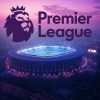Crystal Palace FC
Hailing from South London’s Croydon, with its’ original roots being in the Crystal Palace Exhibition building, Crystal Palace FC, whose origins trace back to 1861, is one of the English teams who compete in the Premier League. Being a club from the country’s capital where there are already several clubs, especially in the southern London region, the club has a lengthy, bitter rivalry with regional rivals Millwall and Charlton Athletic. They also have a rivalry with Brighton & Hove Albion, despite the Seagulls being from a different city.
History and Background
In the beginning, when football wasn’t in the plan
Before a plan to establish a football club was on the cards, the Crystal Palace Company, which owned the exhibition building, established the Crystal Palace Club in 1857 for locals to play cricket. In 1861, the company founded the “Crystal Palace Football Club”. The cricket club and the football team shared the same pitch in Crystal Palace Park, and a large number of the football team’s founding players and management were also cricket club members. The amateur football team which was established participated in the first-ever FA Cup competition in 1871–1872 and made it to the semifinals. The club was one of the original founding members of the Football Association in 1863.
The FA Cup Final’s new, permanent placement was founded by the Football Association in 1895 at the sports stadium positioned inside the Palace grounds. Some while later, the Crystal Palace Company, which relied on tourism revenue, sought out new attractions for the stadium and made the decision to create a new, professional football club to play there. The property owners desired a club to play there and take advantage of the area’s massive crowd potential.
The 1920s: the emergence of a major club and participation in the FA Cup Final
Edmund Goodman, the assistant secretary for Aston Villa, took the lead in the formation of the professional Crystal Palace football team in 1905 The club submitted an application to join the Football League, but it was denied, and for the 1905–06 season, it was placed in the Southern League Second Division. Palace won the Southern League First season that saw them promoted.
When the Suffragettes planned to blow up the stands during the 1913 FA Cup Final, the Palace stadium came dangerously close to being completely destroyed. In the 1920–21 season, the team finished as champions and was promoted to the Second Division. They then became founding members of the Third Division league. In 1924, Palace relocated to a new venue, Selhurst Park, where the team continues to hold home matches today.
In front of 25,000 spectators, Selhurst Park’s debut game saw Palace lose 0-1 to The Wednesday. With a twenty-first-place finish, the team was demoted to the southern Third Division. Before the outbreak of the Second World, the club the War, made an effort to improve, consistently placing in the top half of the standings and coming second three times. Palace had fewer accomplishments in the league after the war; their highest finish was occasions the team had to petition for re-election.
The 1950s-70s: Ascent to the Premier League and the historic battle against champs Real Madrid
The team played in the southern Third Division until the end of the 1957–58 season, at which point the league underwent a restructuring that saw the clubs in the southern Third League’s bottom half combine with those in the northern Third League’s bottom half to create the Fourth Division. Ending their season as fourteenth meant that Palace was now at the lowest they’ve ever been at.
The club made history in 1962 when they faced the legendary Real Madrid squad of the time in a historic friendly match. The Spanish superstars played their first game ever in London, and the Spaniards defeated the Londoners by 4-3. Later in the 1960s, Palace enjoyed excellent campaigns and was twice promoted, in 1963–64 and 1968–69, moving the team up to the First Division’s highest level from the Second Division.
From 1969 into 1973, Palace retained its place in the top division and managed to win several notable victories, the best of which was a 5-0 victory over Manchester United at home during the 1972–73 campaign. After an unforeseen change in management, the club’s spirit and performance slowly deteriorated, and they were relegated to the Second Division in 1973
The 1970s-80s: Hopping between divisions
Due to being relegated once again, the club was on its’ way to facing worse things. Palace was immediately relegated once more and was back in the Third Division for the 1974–75 season, due to poor management that was unfit for the team. The squad then enjoyed a successful run to the 1975–1976 FA Cup semifinals, when the manager was changed, defeating prospering clubs Leeds and Chelsea along the way, but ultimately were beaten by champion Southampton 0–2 at Stamford Bridge.
They earned a promotion to the Premier Division in 1976–1977 and 1978–1979, and during the second year, they even became the Second Division champions. They eventually stooped back to the Second Division from the First in 1980–81, as a result of financial struggles, wop players leaving the club and prevented Palace from retaining its place in the top division.
How Steve Coppell managed to turn the club around in the 80s
Steve Coppell, who’d played for Man United and the England team, had been forced to step down from his playing career and was hired as manager for the Palace on June 4th of ’84. Over the following few years, he managed to turn the club around, and the Eagles were promoted back to the top flight through the playoffs in 1988–89.
The team was able to focus on this achievement, and in the 1990–91 season, they placed third in the top division, which was a record for the club. At the start of the season, Palace’s star striker Ian Wright left the team to sign with Arsenal. By placing tenth, Palace was able to join the Premier League as one of its original members in 1992–1993.
The controversial 90s & 2000s – failed drug tests, relegation and financial crisis
New manager Alan Smith led Palace to the First Division championship and re-promotion to the Premier League. United player Eric Cantona was taunted by a Palace fan named Matthew Simmons during a match between Palace and Manchester United on January 25, 1995, at Selhurst Park. Cantona retaliated with a physical attack, for which he was given a two-week jail sentence. Following an appeal, the sentence was changed to 120 hours of community service. The fan was banned from Selhurst Park and found guilty on two charges of threatening the Man United forward.
More unfortunate news followed for the Eagles, where player Chris Armstrong was given a suspension by the FA for failing a drug test. On the field, Smith led the team to semi-final appearances in the FA Cup and League Cup. However, the club’s league play was uneven, and Palace once again found themselves relegated after placing fourth from the bottom as the Premier League was cut from 22 to 20 clubs.
They suffered a heartbreaking loss in the 1996 First Division play-off championship. At the end of the 1997–98 season, Palace was relegated back to the First Division, which was nothing new for the club, given its’ history of bouncing between divisions. In 1999, Palace entered administration as a result of owner Mark Goldberg’s inability to continue providing the team with financial support.
In 2000–01, the first season under new club owner Simon Jordan, Palace came dangerously close to being relegated back to the Third division. Steve Bruce, a former captain of Manchester United, was chosen as the head coach for the 2001–02 campaign. Palace had hope for a promotion challenge after a strong start to the year.
Under new manager Steve Kember, the team won its first three games of the 2003–04 campaign, putting them atop the league. However, he was fired in November after a disastrous run of form saw Palace slide closer to the relegation zone.
Over the following few years, Simon Jordan was unable to steady the club’s finances, and in early 2010, Palace became increasingly threatened by creditors. After the season, CPFC 2010, a group made up of a few affluent supporters, was successful in negotiating the purchase of the team. Steve Parish, who spoke on behalf of the group of four, managed to get hold of the freehold of Selhurst Park and encouraged Lloyds Bank to sell the stadium back to the club.
Reinstatement into the Premier League in 2010 with a high turnover in management
George Burley was appointed the next Palace manager right away by the new owners, CPFC 2010 The club was unfortunately still hanging at the foot of the standings by December after a terrible start to the next season. On October 23, 2012, manager Dougie Freedman left his position after serving for 1.5 years to take over Bolton Wanderers.
Ian Holloway took over as the new Palace manager in November 2012 After an eight-year nonappearance in the Premier League, he led the team back, but he left on his own a year later. After a brief period under two managers, Alan Pardew, a former Palace player, was officially named the new manager in January 2015 Pardew guided the team to their first FA Cup Final in 26 years in his first full season. Over the following few years, there was a significant change in the club’s management, with many unexpectedly leaving on their own, which the Palace supporters found disappointing.
In 2017, Roy Hodgson, a former England manager, was named as the team’s new head coach. The Premier League standings for Palace were eleventh in Hodgson’s first season, twelve in 2018–19, and fourteen in 2019–2020. When Hodgson’s contract expired at the end of the 2020–21 season, the team confirmed on May 18, 2021, that he would be leaving. In his final year with the club, he finished in fourteenth place. Patrick Vieira, a former player for Arsenal, was hired by Palace on July 4, 2021, with a three-year deal.
Key historical moments and achievements
League and Cup wins
Crystal Palace won EFL League One in 1920–21 and finished second four times in 1928–29, 1930–3, 1938–39, and 1963–64. Crystal Palace’s highest Premier League placing was third in 1990–91, and they won the EFL Championship twice, in 1978–79 and 1993–94. They finished second in 1968–1969 as well. They also won the playoffs in 1988–89, 1996–97, 2003–04, and 2012–13, and finished second in the playoffs in 1995–96.
Crystal Palace became runners-up for the FA Cup twice, in 1989-90 and in 2015-2016, while having won the Full Members Cup in 1990-91.
The team also finished second in the Southern Football League Division One in 1913–14, won the United League in 1906–07 and finished second in the Southern Football League Division Two in 1905–06.
They finished second in the Southern Professional Floodlit Cup in 1958–1959 for this team. Crystal Palace has finished second six times (1919–20, 1921–22, 1922-23, 1931–32, 1937–38, and 1946–47), and has won the London Challenge Cup three times (1912–13, 1913–14, and 1920–21).
The club won the Surrey Senior Cup in 1996–97, 2000–01, and 2001–02, and Crystal Palace won the Kent Senior Shield in 1911–12 before finishing second the following year.
Club Structure
Head coach
Following the resignation of Roy Hodgson, who had led Crystal Palace since 2017, on July 4, 2021, a Frenchman named Patrick Vieira was on a three-year contract. Before Crystal Park, he held managerial positions with Manchester City EDS, New York City FC, and French club Nice.
All of Vieira’s teams have been noted for playing disciplined, possession-based football. When his team is in a difficult place, he has displayed a propensity to turn combative. During his time at Crystal Palace, the counterattacking style of play that had been common under Roy Hodgson’s management gave way to a proactive manner.
Chairmen
Steve Parish, Stephen Browett, Jeremy Hosking, and Martin Long are the chairmen at Crystal Palace. After completing a £3.5 million deal to purchase Selhurst Park from Lloyds Bank, Parish led a partnership known as “CPFC 2010” to acquire Crystal Palace in June 2010 and prevent administration and impending collapse. He was elected chairman and the club’s largest stakeholder.
Parish revealed plans for a £75–100 million redevelopment of Selhurst Park in December 2017 Following Croydon Council’s approval of the project’s planning request in April 2018 Parish unveiled plans for a £20 million revamp of the Club’s Academy in October 2019
Team Players
Current squad
Goalkeepers: Vicente Guaita, Sam Johnstone, Joe Whitworth, Owen Goodman
Defenders: Joel Ward, Tyrick Mitchell, James Tomkins, Marc Guehi, JoachimAndersen, Nathaniel Clyne, Chris Richards, Nathan Ferguson
Midfielders: Luka Milivojevic, Michael Olise, Albert Sambi Lokonga (in on loan), Eberechi Eze, Wilfred Zaha, Jeffrey Schlupp, James McArthur, Will Hughes, Cheick Doucoure, Naouirou Ahamada, Kofi Balmer, Jairo Riedewald, Jack Wells-Morrison, Adler Nascimento, David Ozoh, Kaden Rodney
Forwards: Jordan Ayew, Jean-Philippe Mateta, Odsonne Edouard
The home grounds – Selhurst Park stadium
Selhurst Park stadium is a stadium based in south London and is home to the Crystal Palace football team. It has four stands.
8,329 fans can fit in the Holmesdale Road Stand, which has two levels. The lower tier houses 5,510 seats, while the upper tier houses 2,819. The newest stand of the stadium was constructed in 1994, taking the place of the former terrace end. It makes up the stadium’s southeast corner.
The Arthur Wait Stand can accommodate 9,574 people. Approximately 3,000 of those people are away fans. It debuted in 1969 and was given the chairman of the Palace’s chairman name. It makes up the stadium’s northeast side.
The Main Stand has a capacity of 5,460 people, including 63 press seats. This original stand first opened in 1924 The Directors’ Box, as well as the Main Entrance and new offices, were constructed at the back of the stand. Additionally, during the summer of 2013, new seating was added, including several bars and a restaurant inside the stand. On April 19, 2018, Croydon Council approved plans to build a new 13,500-seat main stand, bringing the stadium’s capacity to 34,000. The new display will have an all-glass facade that is modelled after the original Crystal Palace exhibition structure.
Whitehorse Lane Stand has a capacity of 2,219 people, plus 480 seats for executive boxes. It was renovated in the early 1980s after being constructed initially as a standing terrace. The Family Stand is another name for it among Crystal Palace followers. There are 24 Executive Boxes on the stand. It makes up the stadium’s northwestern corner.
What the future may hold for CPFC
At the moment, CPFC is 12th in the Premier League under manager Vieira’s lead, and since their last 5 games are either a draw or a loss and the fact that they haven’t managed to win a single game, is surely daunting for the club and its’ fans.
Although Vieira, the former France national and Arsenal midfielder, has managed to win over the Eagles’ fans by showing an alluring style of play and overseeing an improvement in results, but also the way he has embraced club culture and traditions, we should expect to see greater ambition, which is what his boys are lacking at the moment. After all, failing to win a game in the previous five games surely isn’t what any team wants.
Fans are optimistic that Crystal Palace will be able to finish in the top 10 of the Premier League standings, but we have yet a lot to see from the Eagles, and manager Vieira should surely try and run a tighter ship in the club, for the club to achieve better results.
FAQ’s
What is the dress code for a Crystal Palace game?
Casual. No shorts, but children under 12 are exempt from this rule. Visitors are requested to follow the casual dress code.
I’m a talented football player. Could I get a trial?
The club doesn’t conduct public trials. They have scouts, who keep an eye on competitions and sports in and around south London. This is where CPFC mostly finds young, promising players.
Can I attend a game between Palace’s U21 or U18 teams?
Unless played at Selhurst Park, academy matches are currently not accessible to the general public.
Does the stadium offer audio commentary of the game for people who are blind or partially sighted?
Yes, there is a free audio commentary service, which is available throughout the stadium. Please call the Disability Liaison Officer at 020 8768 6080 or send an email to [email protected] to make arrangements for a radio and headset.
Is a season ticket card necessary?
All Selhurst Park season tickets and match tickets are digital as per Premier League regulations, allowing entrance to the venue by smartphone.







